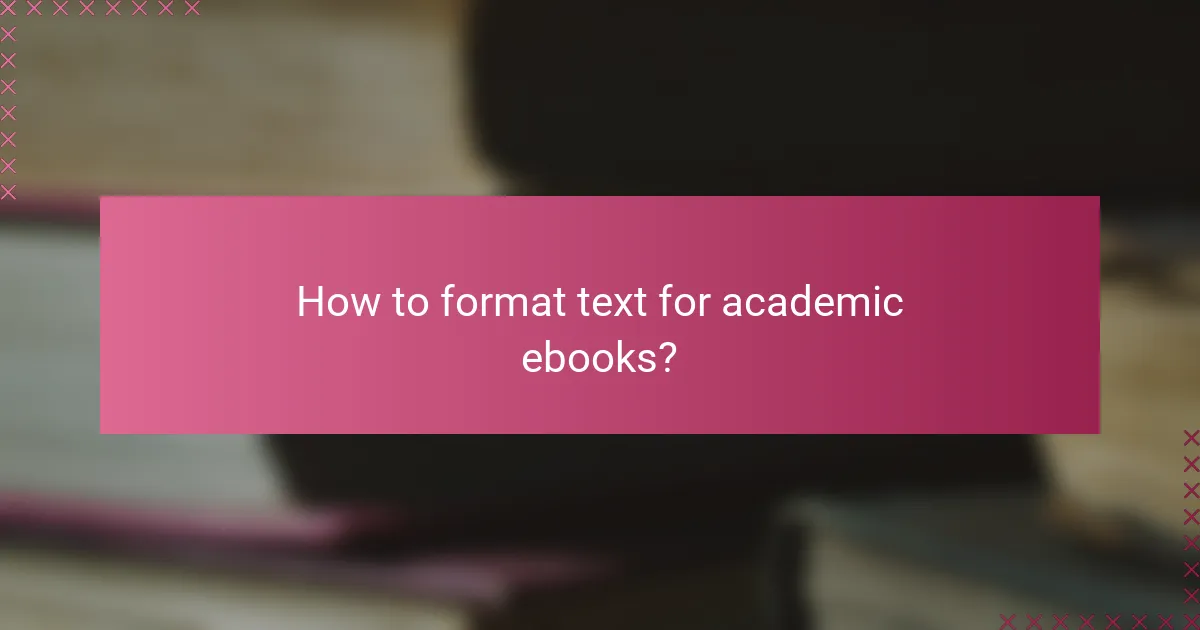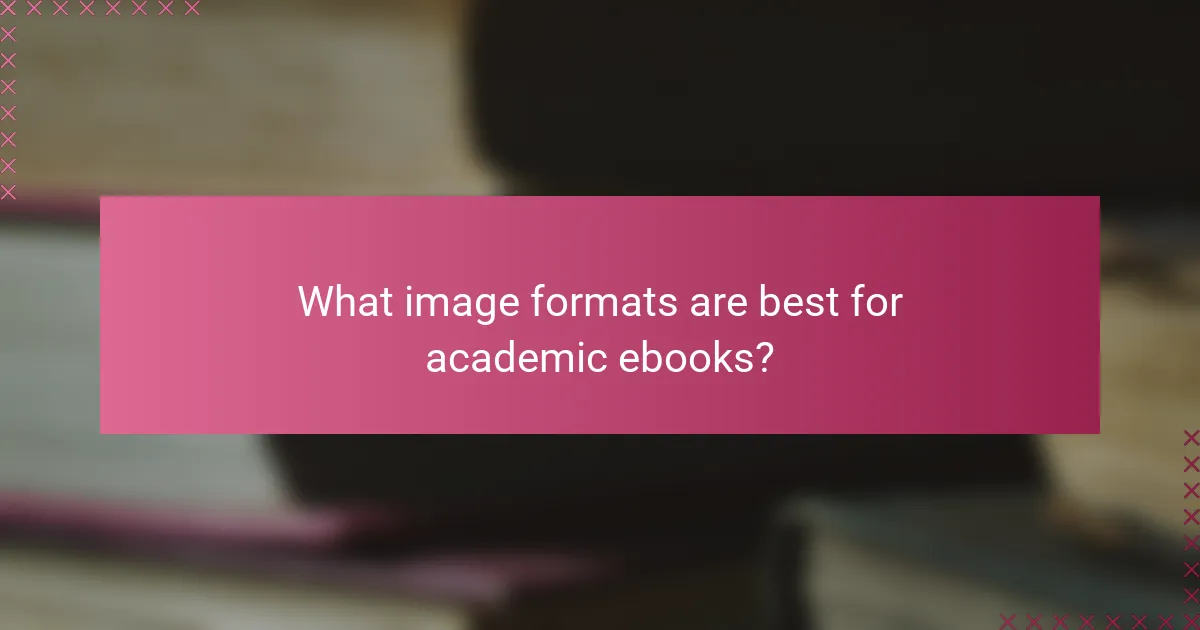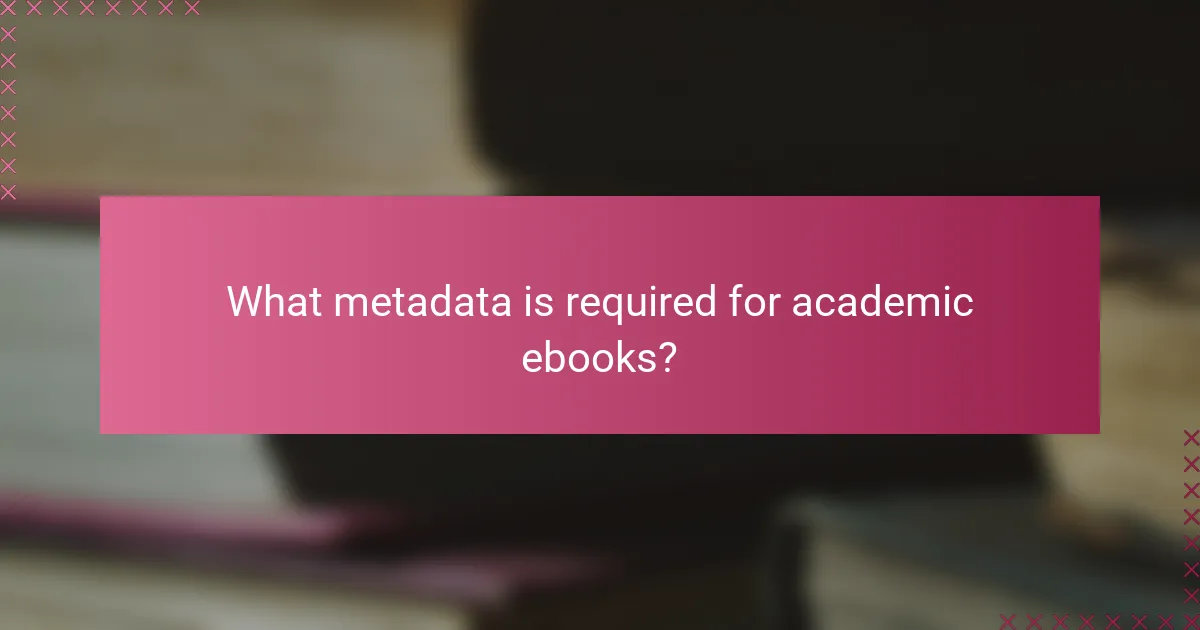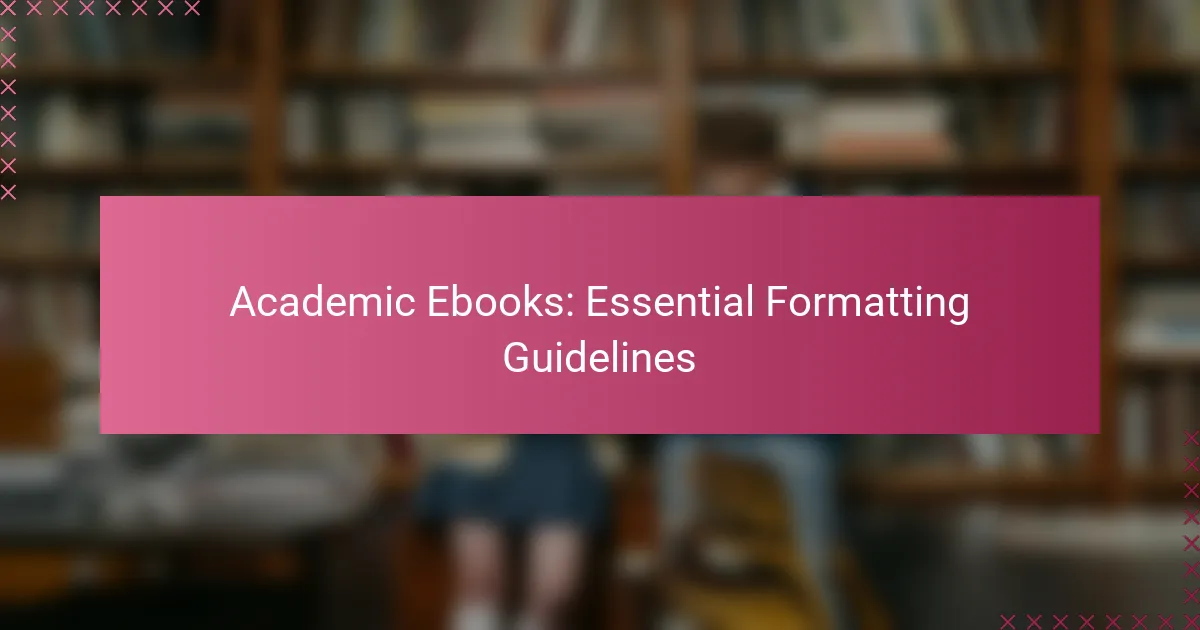Essential formatting guidelines for academic ebooks are crucial for presenting content clearly and professionally, which enhances both readability and accessibility. By following these standards, authors can ensure consistency and improve the overall user experience, making their work more engaging and effective for readers.

What are the essential formatting guidelines for academic ebooks?
Essential formatting guidelines for academic ebooks ensure that content is presented clearly and professionally, enhancing readability and accessibility. Adhering to these standards helps maintain consistency and improves the overall user experience.
Text formatting standards
Text formatting in academic ebooks should prioritize clarity and consistency. Use standard fonts like Times New Roman or Arial, typically sized between 11 and 12 points for body text. Maintain uniform line spacing, ideally 1.5 or double spacing, to enhance readability.
Headings should be clearly distinguished using larger font sizes or bold styles. Consistent use of italics for titles and emphasis is recommended. Avoid excessive use of colors or decorative fonts that may distract from the content.
Image and graphic integration
Images and graphics should be high-resolution and relevant to the content, ideally in formats like JPEG or PNG. Place them close to the related text to provide context, and ensure they are appropriately captioned for clarity.
Consider the layout when integrating graphics; they should not disrupt the flow of text. Use alt text for all images to enhance accessibility for visually impaired readers. Ensure that images are optimized for various devices, maintaining quality across screens.
Table of contents structure
A well-structured table of contents (TOC) is crucial for navigation in academic ebooks. It should list all major sections and subsections with corresponding page numbers or hyperlinks for easy access. Use a hierarchical format to indicate the relationship between sections.
Keep the TOC concise and clear, avoiding overly complex titles. A good practice is to limit the depth of the hierarchy to three levels to prevent confusion. Regularly update the TOC to reflect any changes in the content structure.
Metadata requirements
Metadata is essential for the discoverability of academic ebooks. Include key elements such as the title, author(s), publication date, and ISBN. Descriptive keywords and a brief abstract should also be provided to enhance searchability.
Ensure that metadata complies with standards like Dublin Core or ONIX for Books. This facilitates proper indexing by libraries and search engines, making it easier for readers to find your ebook.
Accessibility considerations
Accessibility is a critical aspect of formatting academic ebooks. Ensure that all text is readable by screen readers, using proper heading structures and alt text for images. Avoid using color as the only means of conveying information.
Consider providing alternative formats, such as audio or Braille, for users with disabilities. Regularly test your ebook with accessibility tools to identify and rectify any issues, ensuring compliance with standards like WCAG 2.1.

How to format text for academic ebooks?
Formatting text for academic ebooks involves selecting appropriate fonts, sizes, line spacing, and margins to enhance readability and professionalism. Proper formatting ensures that the content is accessible and visually appealing to readers, which is crucial in academic publishing.
Font selection and sizes
Choosing the right font and size is essential for clarity in academic ebooks. Commonly used fonts include Times New Roman, Arial, and Calibri, with sizes typically ranging from 11 to 12 points for body text. For headings, consider using larger sizes, such as 14 to 16 points, to create a clear hierarchy.
Ensure that the font is legible across various devices, as many readers will access ebooks on tablets or smartphones. Avoid overly decorative fonts that may distract from the content, and stick to standard styles that are widely accepted in academic circles.
Line spacing and margins
Line spacing and margins play a significant role in the readability of academic ebooks. A line spacing of 1.5 to double spacing is often recommended to provide adequate white space, making the text easier to read. Margins should generally be set to at least 1 inch on all sides to prevent text from being cut off on different devices.
Consider using wider margins for academic ebooks that include footnotes or references, as this allows for additional space without cluttering the main text. Consistent application of these formatting guidelines will enhance the overall presentation and professionalism of the ebook.

What image formats are best for academic ebooks?
The best image formats for academic ebooks are typically JPEG, PNG, and TIFF. These formats balance quality and file size, making them suitable for various types of content, from photographs to illustrations.
Recommended image formats
JPEG is ideal for photographs due to its efficient compression, which reduces file size while maintaining acceptable quality. PNG is preferred for images with transparency or when high-quality graphics are needed, such as charts and diagrams. TIFF is often used for high-resolution images but results in larger file sizes, making it less practical for ebooks.
Image resolution guidelines
For academic ebooks, a resolution of 300 DPI (dots per inch) is recommended for images to ensure clarity and detail, especially for printed versions. For on-screen viewing, a resolution of 72 to 150 DPI is generally sufficient. Always consider the target device’s display capabilities when determining the optimal resolution.

How to create an effective table of contents?
An effective table of contents (TOC) provides a clear roadmap for readers, allowing them to navigate through an academic ebook easily. It should be well-structured, linking to relevant chapters and sections for quick access.
Hierarchical structure
A hierarchical structure in your TOC organizes content from general to specific, making it intuitive for readers. Start with major sections or chapters, followed by subsections that delve into finer details. For instance, if your ebook covers “Biology,” the TOC might list “Cell Biology” and “Genetics” as main sections, with subsections like “Cell Structure” and “DNA Replication” beneath them.
Use clear headings and subheadings to distinguish levels, ensuring that each entry reflects the content accurately. This approach helps maintain a logical flow and enhances the reader’s understanding of the material’s organization.
Linking chapters and sections
Linking chapters and sections in your TOC is crucial for facilitating easy navigation. Each entry should be hyperlinked to its corresponding section in the ebook, allowing readers to jump directly to the content they are interested in. This is especially important in lengthy academic texts where searching for specific information can be time-consuming.
Ensure that links are functional and tested across different devices and formats, as accessibility can vary. Additionally, consider using consistent formatting for links, such as underlining or color changes, to make them easily identifiable. This enhances user experience and encourages deeper engagement with the material.

What metadata is required for academic ebooks?
Academic ebooks require specific metadata to ensure proper identification, discoverability, and management. Key elements include ISBNs, author and publisher details, and other relevant identifiers that facilitate access and citation.
ISBN assignment
Assigning an ISBN (International Standard Book Number) is crucial for academic ebooks as it uniquely identifies the publication. Each format of the ebook (e.g., PDF, EPUB) should have its own ISBN to avoid confusion in cataloging and sales.
When obtaining an ISBN, consider using a reputable agency, such as Bowker in the United States or Nielsen in the UK. An ISBN typically costs between $125 and $250, depending on the quantity purchased, with discounts available for bulk orders.
Author and publisher information
Accurate author and publisher information is essential for academic ebooks, as it establishes credibility and allows readers to locate the source easily. Include the full names of all authors, their affiliations, and the publisher’s name, along with any relevant logos.
Ensure that the author names are formatted consistently and that the publisher’s details comply with industry standards. This information should be included in the ebook’s metadata and visible in the front matter to enhance discoverability in academic databases and libraries.

How to ensure accessibility in academic ebooks?
Ensuring accessibility in academic ebooks involves implementing features that allow all users, including those with disabilities, to access content effectively. This includes adhering to guidelines that enhance usability, such as text-to-speech compatibility and providing alternative text for images.
Text-to-speech compatibility
Text-to-speech compatibility allows users to listen to the content of an ebook, making it accessible for individuals with visual impairments or reading difficulties. To achieve this, ensure that the ebook is formatted in a way that supports screen readers and other assistive technologies.
When creating an ebook, use standard formats like EPUB or PDF/A, which are more likely to be compatible with text-to-speech software. Additionally, avoid complex layouts that can confuse screen readers, and maintain a logical reading order to facilitate smooth navigation.
Alternative text for images
Providing alternative text for images is crucial for users who rely on screen readers to understand visual content. This text should succinctly describe the image’s purpose and context within the ebook, allowing visually impaired readers to grasp the information conveyed.
When adding alternative text, keep it concise—typically one or two sentences. Avoid phrases like “image of” or “picture of,” and focus on the image’s content and relevance. Regularly review your ebook to ensure that all images have appropriate alternative text, as this is a common oversight in digital publishing.
